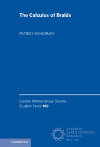- About MAA
- Membership
- MAA Publications
- Periodicals
- Blogs
- MAA Book Series
- MAA Press (an imprint of the AMS)
- MAA Notes
- MAA Reviews
- Mathematical Communication
- Information for Libraries
- Author Resources
- Advertise with MAA
- Meetings
- Competitions
- Programs
- Communities
- MAA Sections
- SIGMAA
- MAA Connect
- Students
- MAA Awards
- Awards Booklets
- Writing Awards
- Teaching Awards
- Service Awards
- Research Awards
- Lecture Awards
- Putnam Competition Individual and Team Winners
- D. E. Shaw Group AMC 8 Awards & Certificates
- Maryam Mirzakhani AMC 10 A Awards & Certificates
- Two Sigma AMC 10 B Awards & Certificates
- Jane Street AMC 12 A Awards & Certificates
- Akamai AMC 12 B Awards & Certificates
- High School Teachers
- News
You are here
The Calculus of Braids

Publisher:
Cambridge University Press
Publication Date:
2021
Number of Pages:
220
Format:
Hardcover
Series:
London Mathematical Society Student Texts
Price:
105.00
ISBN:
978-1108843942
Category:
Textbook
[Reviewed by , on ]
Katherine Vance
07/30/2023
This book is intended as an introductory braid theory textbook. It begins with a chapter modelizing braids, from both geometric and algebraic perspectives, and setting out the braid isotopy problem, i.e. given two braids (in either diagram or braid word form), can we determine whether they represent braids isotopic to each other? Chapter 2 introduces the braid group \( B_{n} \), along with two appendices including the necessary algebraic background on monoid and group presentations. The remainder of the book covers five different solutions to the braid isotopy problem: Garside’s approach based on the submonoid \( B_{n}^{+} \) of the braid group \( B_{n} \), a new solution using a unique normal form for elements of \( B_{n} \), Artin’s approach using the fundamental group of an n-punctured disk, another new approach using handle reduction, and an approach using Dynnikov coordinates. Finally, the last chapter explores extensions and generalizations of braid groups.
The author states that the book assumes a “minimum of preliminary knowledge, never above the level of the first couple of years of university mathematics,” but doesn’t specify which courses would have been taken during those years. Based on my reading of the book, the text assumes a background in analysis and point-set topology, and an abstract algebra course would be very helpful. The author includes some charming asides to student readers, explaining which points are most important to understand deeply and where it is okay to skim through and move on, and encouraging students to push through their confusion in those places. Unfortunately, decoding the text will be a significant barrier for most US
undergraduate readers. Originally published in French, the translation is unwieldy and often uses terms such as abscissa, cutting, and neutral element that will be unfamiliar and confusing to students accustomed to x-coordinate, intersecting, and identity element.
That said, this text is an excellent reference for graduate students and researchers. It is great to have a single, comprehensive resource addressing the braid isotopy problem using so many different approaches. The definitions are thoughtfully constructed and proofs are very thorough and detailed. There are a few exercises in the opening chapters, more in the later chapters, and all have complete, detailed solutions in the back of the book. The index is sparse (it doesn’t contain “homotopy”), but there is a helpful glossary of notation.
Katherine Vance is an Associate Professor of Mathematics and co-Director of Undergraduate Research at Simpson College. Her main research interest is in knot theory.
See the publisher's website.
- Log in to post comments




